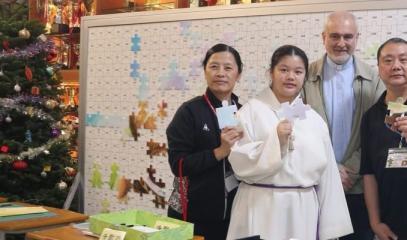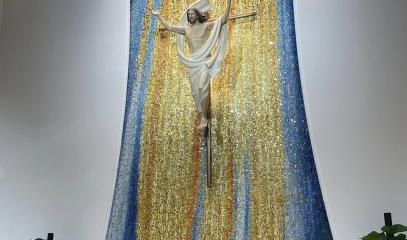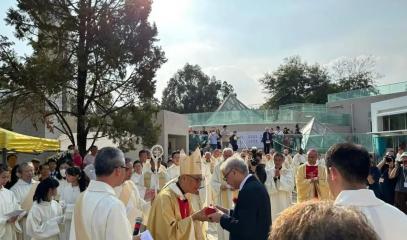Underground church among the high-rises in Hong Kong’s Fanling area
Located in a neighbourhood near the border, the new church of St Joseph parish was consecrated on the Solemnity of the Epiphany. The old church was too small in a fast-growing area with housing projects changing its nature as mainland students and government workers settle in. For Fr Pietro Paolo Dossi, a PIME missionary and the local parish priest, this represents an opportunity for the community to “renew itself”.
Hong Kong (AsiaNews) – Yesterday, the Solemnity of the Epiphany, the Parish of St Joseph, in Hong Kong’s Fanling area, experienced the joy of dedicating its new church.
Located in the North District of the New Territories, just two kilometres from the border with mainland China, the building is underground, in the literal sense of the word – “in the absence of building space, you literally build underground," explains Fr Pietro Paolo Dossi, PIME missionary and the parish priest of this community.
A "historic" church already existed in Fanling, home to a small Catholic community since 1926. But it was from 1949 onward that the community developed progressively when the bishop appointed PIME missionary Fr Ambrogio Poletti to serve the area. At that time only a few dozen Catholics lived here, meeting for celebrations at the site where a parish school now stands.
In 1953, work began on land donated by one of the faithful, Chu Yan Kit, for what would later be called St Joseph's Church. The structure was "built with local stones, square, irregular, all different, like a church of living stones which Jesus mentions in the Gospels," said Father Dossi.
Five years ago, when the renovation of the old church began, plans were laid out to build a new underground structure, connected to the ground level “via escalators and elevators”.
This became necessary because "there is no more building space in the district," the PIME missionary said. Meanwhile, the community has kept growing and the diocese approved the construction of a larger church."
At present, about 200 families take part in Sunday services. The whole parish got ready for the inauguration of the new underground church, which took place yesterday with a solemn celebration led by the bishop of Hong Kong, Card Stephen Chow.
“For six months, every first Mass of the month, we conducted a different activity, retracing the history of the old church, and waiting for the arrival of the new one as if it were a homecoming," Father Dossi explained.
While waiting for the work to be completed, the Fanling parish community used a school to carry out parish activities and perform Eucharistic celebrations.
“Recently, we created a 500-piece puzzle with the image of five loaves and two fishes, from the episode narrated in the Gospel of Mark, in which Jesus says to the disciples: ‘You give them something to eat’,” Fr Dossi said.
“Behind each piece, everyone wrote a prayer, a sign for a community that decides to enter a new place and renew itself, in turn, on an inner level.” The last piece was put in place yesterday with the official opening of the new church.
Hong Kong’s North District, in the New Territories, is highly urbanised. “In recent years, dozens of buildings have been built nearby,” each with “40 floors and 32 flats on each floor,” noted Fr Dossi, who hails from Bergamo (Italy) and runs the parish together with Fr Phongphan Wongarsa, a PIME missionary from Thailand.
According to his calculations, about 30,000 people will arrive in the area surrounding the parish church over the next few years, mostly students and government workers who commute from mainland China.
“In recent years, people hear more and more Mandarin instead of Cantonese,” the missionary explained. This is one aspect of the "sinicisation" policy launched by Beijing since the city was "returned" by the United Kingdom in 1997, while Hongkongers have tried to develop their own identity independent of the former British colonisers and the central government.
“There is a lot of pessimism," the PIME priest laments. Reports of suicides among young people is an everyday occurrence and in general there is very little confidence in the future. Many families from our parish have left for abroad after the events of 2020.”
In Fanling, parishioners are all Hongkongers, plus a hundred Filipino women, almost all employed as domestic workers, while mainland Chinese came in the 1950s and 1960s.
This migration also represents a new challenge for the mission of PIME priests. “We have not yet reached out to the Chinese (mainlanders) who have moved to the district," Father Dossi said, "but they could be the ones to whom we will turn in the future."
ECCLESIA IN ASIA IS THE ASIANEWS NEWSLETTER DEDICATED TO CHRISTIAN COMMUNITIES IN ASIA. TO RECEIVE A WEEKLY UPDATE EVERY SUNDAY, CLICK HERE.










.png)










